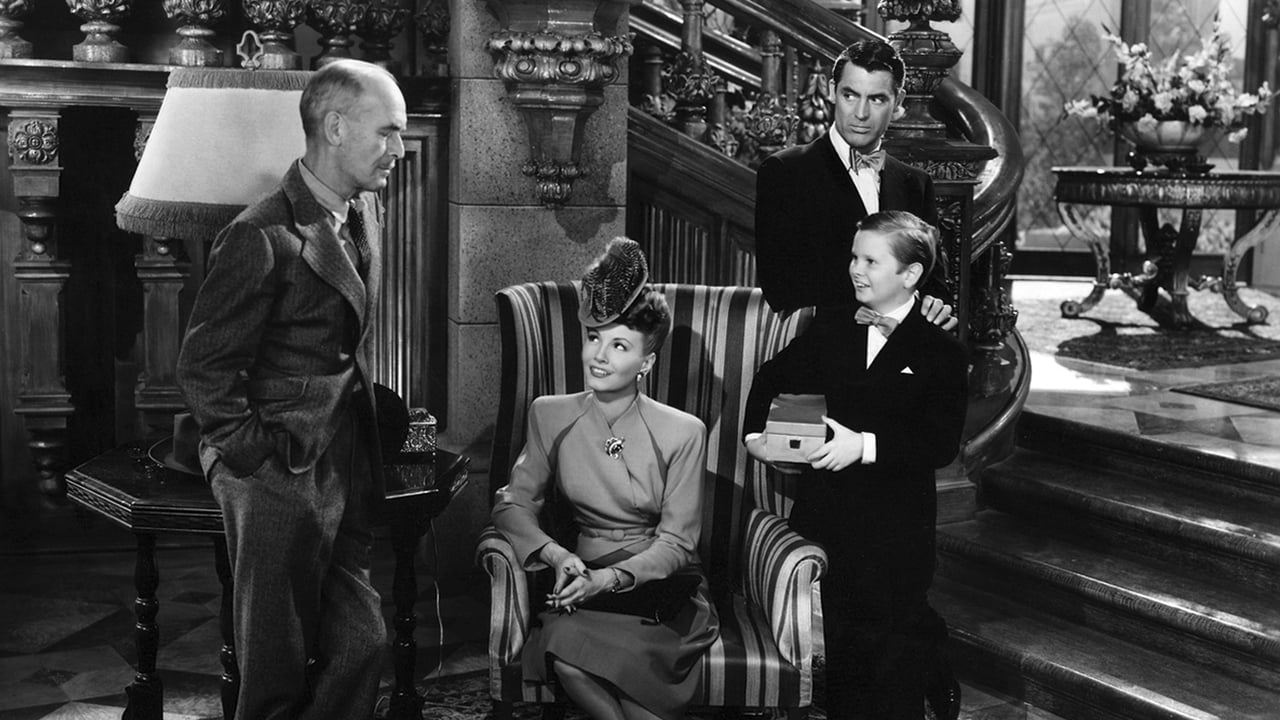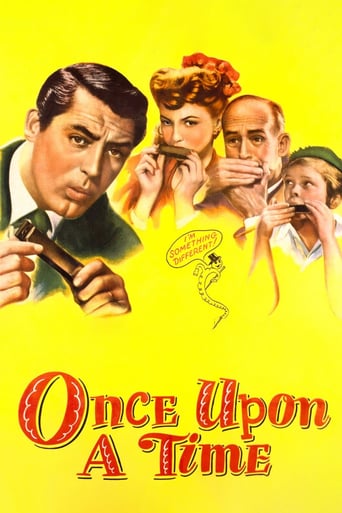

It's all very subjective, of course, when one tries to decide who is the "best American actor" (historically). But for me, it's always been a toss up between Spencer Tracy and Cary Grant, with the edge going to Cary Grant because he was equally comfortable with comedy and drama. But watching film, I've firmly decided that (at least for me) Cary Grant is the greatest American actor (historically).No, it's not because this is a great film. It isn't. It's mildly entertaining.But as I sat watching this film, all I could think was that there probably wasn't another actor who could play the main character and not turn the film into a farce.Think of it. A fantasy about a dancing caterpillar who eventually turns into a butterfly, after bringing a sense of loyalty to a little boy and a sense of hope to a jaded Broadway producer. A dancing caterpillar! And yet, Cary Grant pulled it off with panache! There a list of character actors here whom you'll recognize, including William Demarest. But here the prize goes to James Gleason. Janet Blair is the romantic lead...sort of. But the co-star is really Ted Donaldson -- the little boy.A gem of a film, very offbeat, heartwarming, and handled well so that it didn't become farce.
... View MoreCary Grant got to extend his range in Once Upon A Time and at the same time make a family film that was guaranteed box office. Not a bad win-win situation for him.The extension was having Grant play a not very nice show business producer who is now on his uppers. The theater he built in flush times is now threatened with foreclosure. But the answer just might be in the form of a young kid played by Ted Donaldson with a caterpillar which he keeps in a shoebox who actually gets up dances to the tune of Yes Sir That's My Baby.This rhythmically endowed caterpillar is for real all right, if only Grant can get the marketing rights to him and make the public believe. After some tries that ended in flops he gets Art Baker who played real life radio news broadcaster Gabriel Heatter to see the caterpillar named Curly and give it the kind of radio plug the New York Sun gave to an editorial answer to Virginia's letter about Santa Claus.But an offer from Walt Disney to add Curly to his Magic Kingdom now in formation is too good to pass up. But that would involve breaking young Donaldson's heart and also Grant would be running afoul of the young lad's sister, Janet Blair. Can Cary Grant be that big a heel?Once Upon A Time is a charming fantasy that I'm surprised no one has thought of remaking except the Japanese who did a short subject animated version of this story in the Sixties. I can certainly Tom Cruise and Katie Holmes doing a version of this story, maybe having Justin Bieber play the kid. Instead of Walt Disney they could sell him to Steven Spielberg and a known internet blogger could break the story.I want some screen credit if someone reads this review and sells the idea to Tom Cruise. Until then this is still a fine family film that holds up well even if people today have no idea who Gabriel Heatter was.
... View MoreThis is not a great film by any stretch. But it has it has it's interesting points. A minor comedy by Cary Grant, it came out just before his greatest performance as Ernie Mott in "None But The Lonely Heart". Ernie was the last of a series of heels or near heels that Grant played in serious films from "Suspicion" to "Mr. Lucky" to "Lonely Heart", all of which the studio system and the cult of movie star image crippled from being as good as they might have been. Grant just could not play a villain. Even when he was the unscrupulous Walter Burns in "His Gal Friday", the editor's role was subtly changed by showing that when he wasn't seeking newspaper scoops at everyone else's expense, Walter actually wanted to rid his city (Chicago) of a corrupt Mayor and his gang of relatives. Keep in mind that "His Gal Friday" was a comedy, not a tragic story like "None But The Lonely Heart" or a murder mystery like "Suspicion".ONCE UPON A TIME had been a radio play by Norman Corwin, and had been very successful at the time. The radio play was a fantasy about a little boy who has a pet caterpillar that will dance to the boy playing "Yes Sir, That's My Baby". He meets a theatrical producer who sees "the big picture" about showing the caterpillar to the public. The story line follows how this glitz campaign wrecks the producer's friendship with the boy, until the caterpillar vanishes and they find their relationship again in their concern about the missing pet.It sounds hokey, and is a little, but the story works. Fred Allen had played the ambitious producer in the radio show, and his perfect comic delivery hit the targets of the story. But for the film Allen (despite his wonderful success in "It's In The Bag") was not glamorous enough to carry the movie. Instead it was given to Grant. And here, now in a comedy, the same problem of the image and the desire to stretch as a film performer was fought again. Jerry Flynn is an unscrupulous producer who dreams of having his own theater for his own productions. He has gotten over his head in debt, and he may lose the theater he has a stake in as a result. But he is generally untrusted - and with reason. He will sell anyone for an advantage in the entertainment field. His most persistent critic is the news columnist Brandt (William Demerest) who has seen his shenanigans for years and knows he's an unscrupulous creep. And behaves that way for most of the film - once he discovers the caterpillar's talent to dance. He gives it the full treatment, much to the dismay of the boy's sister Jeannie (Janet Blair) and the growing disillusion of the boy "Pinkie" (Ted Donaldson). Brandt keeps sniping, suspecting everything that Flynn is up to - and finally (when Flynn seems to have beaten him) Brandt shows his moral superiority. Demerest says, "I'm only sorry that such a wonderful thing has to be controlled by you!" It actually does summarize the unscrupulousness of the character.If the original play had not been comic, and had not allowed for Flynn's moral regeneration I doubt if Grant's agent would have agreed to allow him to do it. Up to the middle of the film one dislikes Flynn's activities, especially as they hurt Pinkie and his sister (who, in the course of the film, falls for Flynn). It being a comedy there are moments when Flynn errs. The scene where he tells his aide "the Moke" (James Gleason) to let the telephone ring, expecting it is a call from Walt Disney about using the caterpillar is amusing - when it turns out he's wrong. But the audience wants to be wrong. His eventual realization that there is more to life than success in business or art helps make the character palatable, but it does not ring as true as if Flynn had remained the user/huckster he was to the end.The performances are fine (especially Demerest). But it is minor Grant, and it is ironic that it came just before he came closest to his acting peak.
... View MoreA truly happy film produced in the middle of World War Two. The fantasy of the caterpillar which turns into a butterfly is well-worn, yet always popular. To a large degree, the war is ignored, yet due to the pervasive nature of long-term world conflict, some allusions to the conflict are noted. Especially pointed is the crew of the B-17 bomber who name their plane "Curly" after the caterpillar. They highlight the event with: "I've been in London, Chun King, and Malta and saw kids dodge bombs to try to save some mangey dog." Why not save a dancing caterpillar? The remarkable thing about this film is how many times one sees the caterpillar. Curly the caterpillar is a welcomed respite from the drudgery of prolonged war. Even with one hundred and fifteen credited actors, in this movie fantasy is the real star.
... View More